
So here begins the Big FAT (pun intended) Indian festive season today with Ganesh Chaturthi and will be followed by Eid, Durga Puja or Navaratri, Diwalifor next couple of months. Anyways, back to my favourite topic, ‘foods of festivals’ before I get carried away with the ‘festival-fair’! To me it’s more like ‘festival of foods’. I believe foods are the second best thing in any festivals after the most important thing, people who celebrate. Every festival has handful of special platters to spread during the celebration. For example Ganesh Utsav is a festival to honour Lord Ganesha, the elephant God and it is celebrated with Ganesha’s favourite items like Modaksand Laddu aka Laddoo with many other sweets and desserts. You may have noticed that these sweets are mostly deep fried in ghee (clarified butter) and soaked in heavy sugar syrup. And indulgence with these calorie high foods is nothing less than a crime for weight watchers like us. Such a pity! Let’s celebrate this Ganesh Chaturthi in a Healthy way without compromising the taste. Let’s BAKE Modaks instead of Frying this year. Sounds crazy? Hope in to view the recipe and celebrate Health with prayers, Wealth will find us on the way!

India is a multicultural country with a large number of regions. As a result we get to enjoy almost a festival each day. If we dig more I’m sure we can find even more than one festival on a single day sometimes. Top of that some international celebrations like Thanks Giving, Christmas, New Year, Easter etc. has also sneaked in to our society. Thanks to the globalization and rapidly growing social media. So the new scenario is we are biting Gujiyas or karanjis on Holi and on the next day we are enjoying Easter special Chocolate Cake with Egg Brownies. So it doesn’t matter how much we are busting our asses off in gyms or health clubs. Gradually we are ending up piling kilos, resulting sad depressed moments and some more alone time. (Experience speaks the truth, always!)
I’ve spent all my energy and time on treadmill in past few months which I refuse to lose on the sake of festival on a single day. It’s our health, our hard work and it definitely has to be our choice. So here is my little (daring) experiment with Indian traditional Modak and the result is beyond delicious, I can assure! Now I can celebrate from the bottom of my heart with Baked Modak instead of my previous Fried Modaks. And also now I’ve understood the true meaning of Taste bhi, Healthy bhi (taste and health both)!

Modak is basically a sweet dumpling or hand pie which has two variations, steamed modakand fried modak. It has a soft filling of desiccated coconut and jaggery mixed with cardamom or other flavours. And the outer skin varies for steamed and fried versions. Where rice flour is used for the steamed version, all-purpose or wheat flour is used for the fried version. Modak is an Indian version of deep fried Hand Pie made with flour pastry sheets & sweet filling. It is very popular in west and south India and prepared in most households of these regions during Ganesh festival as it is believed to be most favorite item of Lord Ganesha. (Hey, I always knew Ladduis the thing for him, isn’t it?)

As west India and sound India covers almost half land of India, including different states modak has various names with variations as per local taste. While it’s named as Modakin Maharashtra and Konkani region, western part of India, people in Karnataka know this as modhaka or kadubu; Again in Tamil & Telugu it is called as Kozhakkattai & Kudumu, respectively. It is very common to have different names for a similar recipes as it may vary region to region but the core ingredients or essence of the dish stays similar, just like my last published recipe Rava Kesari or Suji Halwa which is also known as Mishti Sooji or Kesari Bhath.
Anyways, here I baked those modaks in oven instead of deep frying to cut down the excess calories without affecting the taste so that I can enjoy the guilt free flavour of modaks. Surely it explains the extra deliciousness.

So, enough of history-geography lecture from a foodie’s view and now sticking back to original plan, on sharing the recipe of Oven Baked Modak.
By the way, I’ve used my microwave version of Homemade Khoya/Mawa for this recipe.
Preparation Time: 10 mins
Cooking Time: 10 mins + (20 mins + 20 mins) (I cooked modaks in two separate batches)
Resting time: 00 mins
Total Time: 60 mins
Yield: 30 medium sized Modaks
Ingredients:
Read the entire recipe and tips carefully before you start cooking.
Do make sure all ingredients are at room temperature (unless mentioned) and weighted or measured correctly in appropriate weighing machine or measuring instruments such as cups or spoons. Remember these are not our regular cups or spoons which we use in ourdaily life.
For the Stuffing:
Desiccated coconut: 2½ cups
Finely grated Jaggery: 1 cup (See Tips)
Khoya/mawa: ¼ cup (optional), homemadeor store bought
Green cardamom powder: ½ tsp (or essence: 2 drops)
For the Pastry Shell:
All-purpose flour: 2 cup
Ghee (clarified butter): 3 tbsp (or regular salted butter) (See Tips)
Salt: ¼ tsp
Cold water: 1/3 cup to ½ cup

Preparation:
You can use either homemadeor store bought khoya/mawafor this recipe but remember the khoya/mawa needs to be fresh and moist but definitely not watery or dry.
Start with the Cooking the Stuffing:
If you can’t find desiccated coconut use regular coconut and scrape off 1 whole coconut. Make very tiny pieces of jaggery. Take desiccated coconut in a dry pan and stir lightly on medium low flame. Stir continuously to avoid burning coconut flakes. Coconut will turn into golden brown soon. Finally coconut will be reddish brown in color but definitely not burnt. At this point add ground green cardamom and stir on lowest possible flame.
Once mixed nicely, add grated jaggery and stir to incorporate everything. In the beginning it will seem impossible to stir but eventually coconut and jaggery will come together and form a big lump. Stir continuously to avoid sticking at the bottom. Jaggery will release some liquid and mixture will turn moist, may be liquidy at some point. Continue stirring until mixture leaves pan smoothly.
Add khoya or mawa to the pan at this point, if using any at all and mix gently. The mixture will be pale and bit lumpy by now, don’t panic it will be dark again once moisture will evaporate. Scrape off the side & the bottom of the pan, don’t miss it, these are extra delicious, sometimes better than the original filling.
Once mixture is dark yet moist, it is ready as stuffing.
Let’s do a little test to confirm. Take a very small portion of mixture in your palm and roll it between your palms to form a ball. If it forms a fine crack free ball, your filling is done. Remember it’s too hot now. Apply little ghee on your palm to avoid burning.
Remove the pan from fire and keep aside. Let it cool just for few mins. Make very small balls out of it while it’s still warm.

Preparing the Dough for Pastry:
In a large bowl sieve and sift the flour and salt together, twice. Add 1.5 tbsp to 2 tbsp of melted ghee (clarified butter) or regular salted butter to the flour and mix either with your palms or a rubber spatula for 1-2 mins or until mixture looks like crumble. (See Tips)
Make a small well in middle of the mixture and pour cold water in and start kneading with your palms. In the beginning it will look like a big mess. But gradually it will produce super soft & smooth pliable dough. (See Tips)
Cover the dough with cling film and allow it to rest for 30 mins to overnight in refrigerator. (I always keep overnight unless I’m in hurry). After the resting period the dough will be pliable comfortably. (See Tips) Now use the dough whenever you are ready to bake.
Preparing or Forming the Modaks for baking:
Knead the dough lightly for 1-2 mins to make sure it is completely pliable and smooth before using. (See Tips)
Divide the entire dough in two or three parts; keep one portion on kitchen counter and rest wrapped in cling film and refrigerate until needed. Form a log of dough by rolling it on a flat surface. Cut roundels from the log with a sharp knife. Take each roundel in palms and make round ball out of it and keep aside. Do the same with rest of the dough. Keep dough balls covered.
Make 10 small balls from each large chunks of dough. (See Tips)
Take one dough ball at a time and roll out to thin disc or circular sheet using rolling pin. Take the roti like disc in your palm and start pinching around the edge gently with your fingers to create a pocket in the middle. Drop a small ball of stuffing inside the pocket; bring the pleated edges together with your fingers on the top and seal the deal by pinching & pressing together. Also shape the sides if necessary and modak is ready to be cooked.
If you are having any trouble to arrange the pleats evenly or facing trouble in handling to stuff, use another procedure to shape the modak. Place stuffing in the middle of the roti. And start pinching around the edge to form a pocket. Pull the pleats on top and start gathering above; seal by pressing and pinching, same manner as before.
Avoid pressing the modaks with pressure as they are still very soft and fragile. Follow the same with the rest of the dough. You can even use different molds to create new shapes & sizes. (See Tips)

Feeling dizzy? A quick recap for you to remind the steps easily,
1. Stuffing in the middle
2. Pinch around rim to pleat neatly, rotate in between
3. Pull, press, twist & rotate
4. Pinch the top and rotate
5. That’s it! Do the same with rest of the dough
Place the modaks in a covered bowl/pan until needed. While working with one portion of the dough; keep the rest of the dough covered. (See Tips)
Baking the Modaks:
Place all the Modak in a greased (use reserved ghee) baking pan and arrange in a single layer. Brush them with ghee/butter/oil and pop in a preheated (1800C) oven. Bake the Modak at 1800C for 20 mins (depending on the oven). Remove from oven grease modaks slightly if you feel necessary and bake for another 10-15 mins at 2200C to achieve the even golden brown color.
Once done, remove the pan from oven and keep on wire rack to bring to room temperature.
Oven Baked Modak is all set to serve fresh. It tastes best when served warm, freshly baked. But it remains crunchy (may be as good as fresh) at room temperature for 8 to10 days. I can never save those more than that regardless how many batches I bake. Arrange the excess Baked Modak in any air tight container and store at room temperature. I never refrigerate my Baked Modak. As I like them little warm personally, I always microwave them for 10-15 secs before consumption.

Variations:
1. Use dry fruits of your choice; there are no rules & regulations.
2. Create some variations with coconut, moong dal, semolina or may be a combination of them.
3. Substitute jaggery with sugar or mixed of sugar and khoya or condensed milk.
4. Finally, you can always deep/shallow fry them instead of baking; but only if you insist.
Tips:
1. Substitute the jaggery with equal amount of sugar or condensed milk or ground sugar substitute. If you’re using sugar substitute then add it towards the end of cooking not at the beginning.
2. If you are using salted butter for kneading the dough, omit the salt specified in ingredients.
3. The entire process of cooking of stuffing will take 6-10 mins maximum for the specified amount.
4. While mixing ghee (or butter) and flour, be careful to mix thoroughly. It is important to coat the flour with the fat to restrict the gluten to develop.
5. Once wet ingredient is added to the mixture, don’t over mix things. This will lead to stiff dough.
6. Kneading the dough again will ensure to release air bubbles from the dough, if presents any.
7. You can adjust the number according to your desired size of the balls. But don’t make the size too big, it will be messy to stuff them later.
8. If you leave the dough in open air while you are working with small balls, it will lose the moisture and will become too dry for shaping.
9. It is important to keep the dough covered with cling film to avoid dry stretchy dough.
10. You can also use any molds of your choice.

For more Ganesh Chaturthi special recipes please click the following link
http://www.scratchingcanvas.com/p/recipe-index.html?GaneshChaturthi
You may also like
Ganpati Bappa Morya! Mangal Murti Morya!!




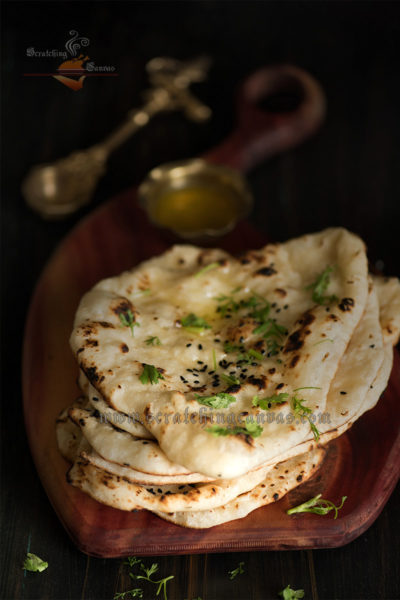
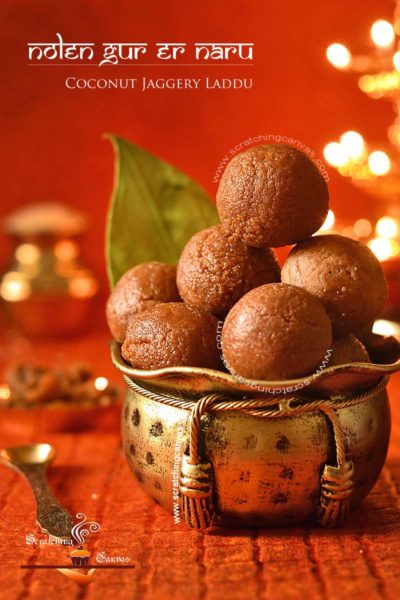
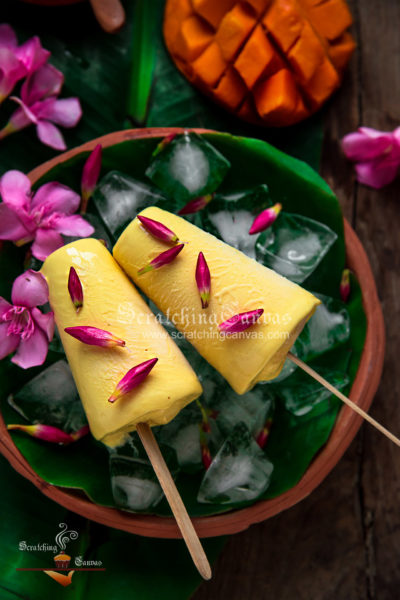
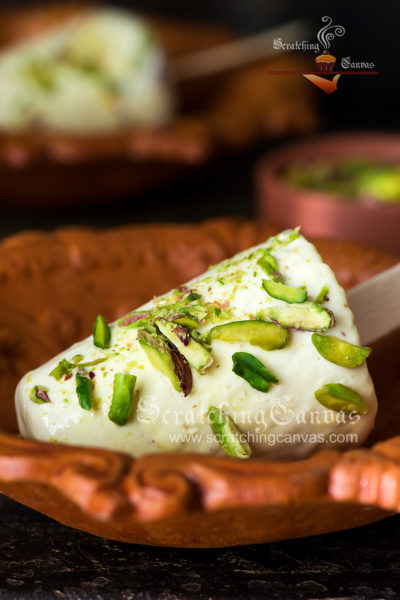
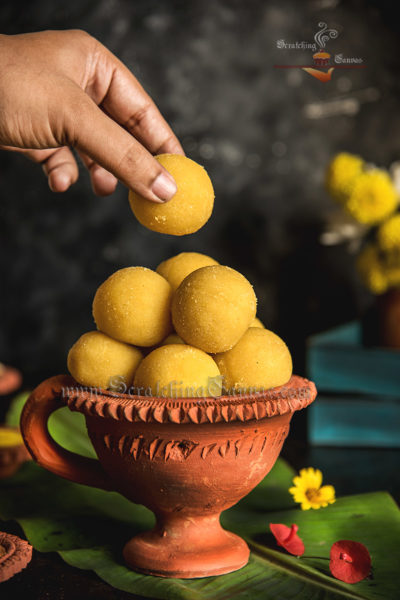
wow rim you have nailed the modak and baked version is more healthier 🙂 Khub Khub bhalo lagache .. Love the video tutorial too.. Keep rocking!!
Thank you so much Manju. I love the way you speak my tongue 😀